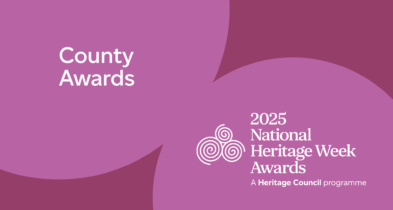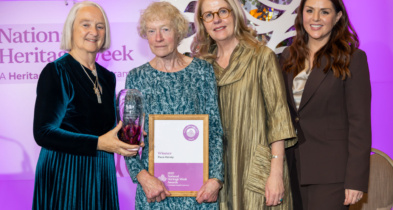
Safeguarding Ireland’s Intangible Cultural Heritage

Sarah Trimble works in the Department of Tourism, Culture, Arts, Gaeltacht, Sports and Media and is based in the International Cultural Policy Unit. One of her key areas of responsibility is Intangible Cultural Heritage (ICH), which involves updating the National Inventory of Intangible Cultural Heritage (NICH) Website, organising events to help promote and safeguard ICH practices, supporting applicants seeking inscription on the NICH, and coordinating meetings of the Expert Advisory Committee on ICH.
Have you ever stopped and taken a moment to consider all the things important to you that make up your culture, your heritage? What elements are most important to you? Is it a tradition, craft or social practice passed on through your family or community for generations? Or perhaps it is a particular skill or practice that is at risk of being lost if the knowledge is not shared and continued for years to come?
These invaluable and in some circumstances at risk practices are often referred to as ‘Intangible Cultural Heritage’ and this post explains how the Department works with many practitioners and organisations to help protect Ireland’s intangible cultural heritage and keep it alive for future generations.
Intangible cultural heritage plays an important role in maintaining cultural diversity. Not only does ‘cultural heritage’ include monuments, buildings, structures and objects, it also includes the skills and traditions that are passed down from generation to generation. Inherited from our ancestors and passed down to our descendants, these invaluable pieces of intangible cultural heritage include oral traditions, performing arts, social practices, traditional crafts as well as knowledge and practices concerning nature and the universe. It is important to keep these traditions alive through safeguarding efforts and supporting their intergenerational transmission. Otherwise, many elements of Ireland’s intangible cultural heritage could be lost forever.
UNESCO 2003 Convention
This year marks the 20th Anniversary of the establishment of the UNESCO 2003 Convention for the Safeguarding of the Intangible Cultural Heritage
It is from this convention that we get many of the definitions of what constitutes intangible cultural heritage. For example, Intangible cultural heritage is defined in this convention as referring to the practices, expressions, knowledge and skills that communities and groups recognise as part of their cultural heritage. It is passed from generation to generation and is recognised under one or more of the following categories:
• Oral traditions and expressions;
• Performing arts;
• Social practices, rituals and festive events;
• Knowledge and practices concerning nature and the universe; and
• Traditional craftsmanship.
The purpose of the Convention is not just to define what intangible cultural heritage is, but also to safeguard it; to ensure respect for the intangible cultural heritage of the communities, groups and individuals concerned; to raise awareness at the local, national and international levels of its’ importance; ensuring mutual appreciation thereof; and to provide for international cooperation and assistance.
Ireland’s Intangible Cultural Heritage

In December 2015 Ireland ratified this 2003 UNESCO Convention for the Safeguarding of the Intangible Cultural Heritage, with the aim to safeguard, appreciate and raise awareness of Ireland’s Intangible Cultural Heritage.
Ireland’s obligations under the 2003 Convention include establishing a National Inventory for Intangible Cultural Heritage to protect, promote and celebrate Irish living cultural heritage practices, customs, crafts and traditions, locally, nationally, and internationally. In 2019 the National Inventory was officially launched by the Minister for Culture and to date has 38 elements of Ireland’s living heritage inscribed.
Applications to the National Inventory of Intangible Cultural Heritage continue to be accepted by the Department of Tourism, Culture, Arts, Gaeltacht, Sport and Media on an ongoing basis. The applications are assessed by an Expert Advisory Committee who consider whether the nominated element is an example of Intangible Cultural Heritage (as defined in the 2003 Convention), as well as whether there is adequate community support & engagement for the element and whether the nominated element is passed from generation to generation.
The Committee then provide their recommendations to the Minister of Culture.
You can find out more about the National Inventory of Intangible Cultural Heritage, as well as the Department’s vision, mission and principles for intangible cultural heritage at https://nationalinventoryich.chg.gov.ie/about/
Last year, Ireland submitted its periodic report to UNESCO to outline the legislative, regulatory and other measures untaken for the safeguarding of intangible cultural heritage. The preparation of Ireland’s report focused on the broad surveying of and engagement with relevant stakeholders and the findings of the report will help inform and guide plans and priorities for safeguarding of intangible cultural heritage over the coming years, while incorporating the Vision, Mission and Principles outlined for ICH in Ireland. Ireland’s Periodic Reports can be downloaded at here.
UNESCO Representative List of the Intangible Cultural Heritage of Humanity
Successful applicants to the National Inventory may also be put forward by the State for inscription on the UNESCO Representative List of the Intangible Cultural Heritage of Humanity, to which the State is entitled to make one nomination every year.

To date, Ireland has successfully inscribed four elements of our Intangible Cultural Heritage on the UNESCO Representative List of Intangible Cultural Heritage of Humanity. Uilleann Piping was inscribed in 2017, Hurling in 2018, Irish Harping in 2019 and most recently Falconry in 2021, which joined the existing multinational inscription of Falconry.
In March this year an application (led by Ireland) was submitted to UNESCO to include Ireland, Austria, Andorra, Belgium and Luxembourg on the existing Dry Stone Construction inscription on the UNESCO Representative List of Intangible Cultural Heritage of Humanity. We eagerly await UNESCO’s decision on this application, which is expected in December 2024!
By achieving international recognition of these practices, in close cooperation with the communities concerned, their safeguarding is supported for future generations. It also serves to acknowledge and celebrate the work of the generations who have kept these traditions alive and provides a wonderful opportunity to share these cherished aspects of Irish culture with others.
Promoting and Safeguarding Ireland’s Intangible Cultural Heritage
The Department of the Tourism, Culture, Arts, Gaeltact, Sport and Media, alongside the practitioners of intangible cultural heritage and the relevant stakeholders are committed to supporting the safeguarding of Ireland’s Intangible Cultural Heritage for future generations.
Applications for inscription on Ireland’s National Inventory of Intangible Cultural Heritage can be submitted at any time to the Department of Tourism, Culture, Arts, Gaeltacht, Sport and Media. For further information on how to apply and the criteria required please see Ireland’s National Inventory of Intangible Cultural Heritage Website.

National Heritage Week 2023
And of course, don’t forget to check out the National Heritage Week website
to see what events are happening near you that help promote and safeguard Ireland’s intangible cultural heritage. Taking place from 12th to 20th
August and focusing on the theme of ‘Living Heritage’, this year’s National Heritage Week is sure to be an exciting week full of opportunities to explore our traditions, practices, knowledge and skills. You can also register to host an event/project at https://www.heritageweek.ie/get-involved/organise-an-event



